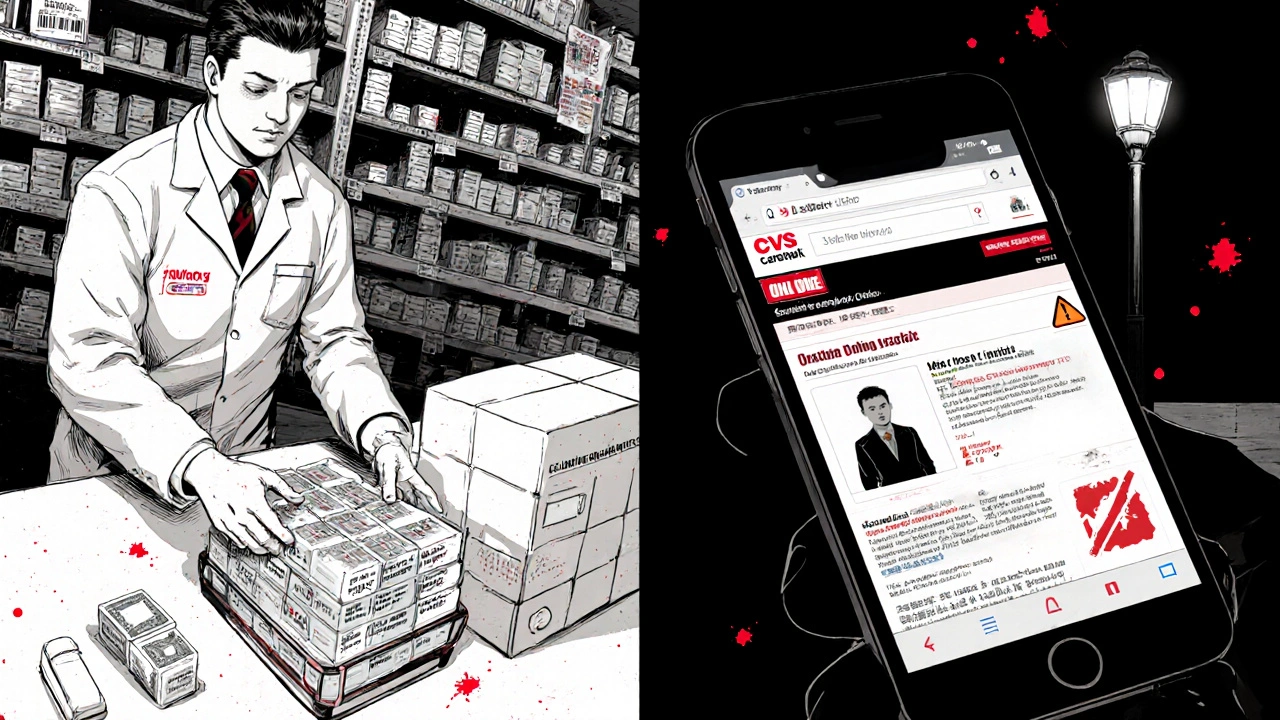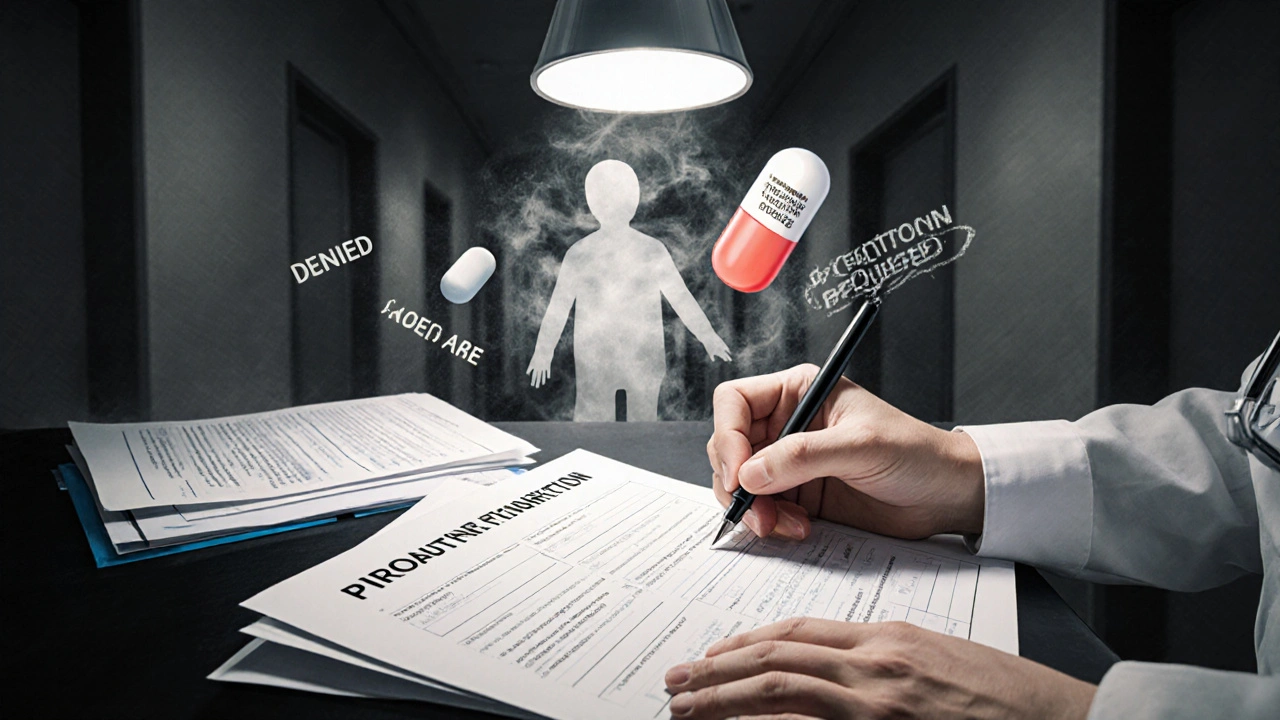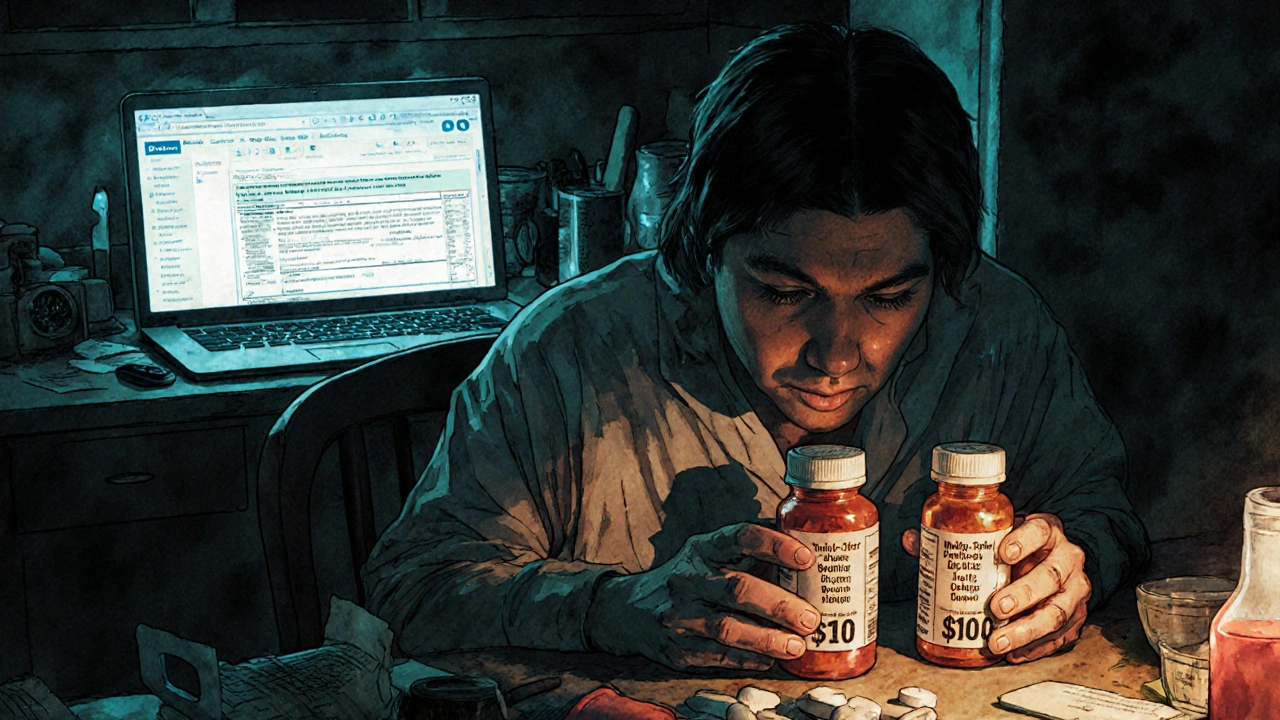When you buy generic medications from an online pharmacy, your insurance might not cover it - even if you think it should. This isn’t a glitch. It’s how the system works. Many people assume that if a drug is generic and FDA-approved, insurance will pay for it the same way it does at your local pharmacy. But that’s not always true. The difference between a mail-order pharmacy tied to your plan and an independent online pharmacy can mean paying $5 or $100 for the same pill.
How Insurance Actually Covers Generic Drugs
Your health plan doesn’t cover drugs directly. It covers them through a Pharmacy Benefit Manager (PBM) - companies like CVS Caremark, Express Scripts, or Optum Rx. These PBMs build a list called a formulary, which ranks drugs into tiers. Generics almost always sit in Tier 1, the cheapest. That means you pay a fixed copay, not a percentage of the drug’s price. For example, if your plan covers a 30-day supply of generic lisinopril, you might pay $5 at a retail pharmacy. If you get a 90-day supply through mail-order, it could still be $10. That’s not a mistake. It’s a design. Insurers want you to buy in bulk because it’s cheaper for them to ship three months’ worth at once than to process three separate refills. But here’s the catch: this only works if the pharmacy is in your plan’s network. If you order from a random website that says it accepts insurance, your claim might get denied. Why? Because that pharmacy isn’t connected to your PBM’s system. You’ll pay full price upfront and then try to get reimbursed - if your plan even allows it.Mail-Order vs. Independent Online Pharmacies
Not all online pharmacies are the same. There are two types:- Mail-order pharmacies are part of your insurance network. They’re run by your PBM. You get your meds by mail, usually in 90-day supplies. Delivery takes about a week. Copays are lower because you’re buying in bulk.
- Independent online pharmacies are like Amazon or Walmart’s online pharmacy. They may accept insurance, but only if they’re in your plan’s network. Most don’t. They often let you pay out-of-pocket and use tools like GoodRx for discounts.
What Happens When Your Insurance Forces a Generic Switch
You might wake up one day and find your brand-name medication replaced with a generic - without your doctor’s input. This is called “non-medical switching.” It’s legal, common, and driven by cost. Insurers do this because generics cost 80-90% less. A 2023 survey found that 68% of large employers require generic substitution when available. Your doctor might have prescribed Brand X because it worked better for your body. But if the generic is FDA-approved, your insurer doesn’t care. They’ll deny coverage for the brand unless you jump through hoops. To fight this, you need a prior authorization. Your doctor has to submit paperwork explaining why the brand is medically necessary. For some conditions - like epilepsy, thyroid disorders, or autoimmune diseases - this is critical. One patient with multiple sclerosis reported severe side effects after being switched to an unapproved generic. She ended up in the ER.
How to Check If Your Insurance Covers a Generic Online
Before you click “buy,” do this:- Log into your insurer’s member portal. Look for a tool called “Check Drug Cost & Coverage” or “Medicine Search.”
- Enter the name of the generic drug. Make sure you’re spelling it exactly right.
- See which tier it’s on and what your copay is.
- Check if mail-order is available. If yes, you can request a 90-day supply.
- Search for the online pharmacy you want to use. If it’s not listed as a network pharmacy, don’t use it for insurance claims.
When Paying Cash Beats Insurance
Sometimes, your insurance copay is higher than the cash price. This happens most often with high-deductible plans. If you haven’t met your deductible, you’re paying full price anyway. Walmart, Costco, and Kroger offer dozens of generic drugs for $10 or less for a 90-day supply - no insurance needed. For example:- Lisinopril 20 mg: $10 for 90 tablets
- Metformin 500 mg: $10 for 90 tablets
- Atorvastatin 20 mg: $10 for 90 tablets
Amazon RxPass and Other New Models
Amazon Pharmacy launched RxPass in 2023. For $5 a month, Prime members get unlimited access to over 100 common generic medications. No copay. No deductible. No insurance needed. It’s not perfect. It only covers a limited list of drugs - mostly for blood pressure, cholesterol, diabetes, and acid reflux. If you take something rare, like a specialty thyroid med, it won’t be included. But for the 30-40% of Americans on maintenance meds, it’s a game-changer. This model is disrupting traditional insurance. Why pay $10 per refill through your PBM when you can pay $5 monthly for everything on the list? It’s not insurance. It’s a subscription. And it’s growing fast.
What to Do If Your Claim Gets Denied
If you ordered from a pharmacy you thought was covered - and your claim was rejected - here’s what to do:- Call your insurer. Ask why the claim was denied. Was it out-of-network? Was the drug not on the formulary?
- Ask for a copy of your plan’s formulary. You have the right to see it.
- If it was an out-of-network pharmacy, ask if you can submit a reimbursement request. Some plans allow it, but you’ll need to pay the full price first.
- If you were switched to a generic without notice and had bad side effects, file a formal exception request with your doctor’s help.
Who to Call for Help
Most insurers offer free 24/7 nurse lines. For example, MHBP members can call 1-800-556-1555. These nurses can explain your formulary, check drug costs, and even help you request prior authorizations. You can also contact your pharmacy benefit manager directly. CVS Caremark, Express Scripts, and Optum Rx all have customer service lines. Don’t assume your insurer knows everything. PBMs run the show.Final Tips to Avoid Costly Mistakes
- Never assume an online pharmacy accepts your insurance - verify it first.
- Use your insurer’s tools to check coverage before you order.
- Compare cash prices with your copay. Sometimes cash is cheaper.
- If you’re on a high-deductible plan, consider RxPass or discount programs.
- Keep a list of all your meds and their generic names. You’ll need it.
- Ask your doctor: “Is there a generic version? Is it covered by my plan?”
Do all online pharmacies accept insurance?
No. Only pharmacies in your insurance plan’s network accept insurance claims. Most independent online pharmacies - including many popular websites - are out-of-network. They may let you pay cash or use discount cards, but your insurer won’t pay for them. Always check your plan’s list of approved pharmacies before ordering.
Can I use GoodRx with my insurance?
You can’t use GoodRx and insurance together on the same transaction. But you can compare the GoodRx price with your insurance copay and choose the lower one. Sometimes GoodRx is cheaper, especially if you haven’t met your deductible. Always check both before paying.
Why does my insurance only cover 90-day supplies through mail-order?
Insurers encourage 90-day supplies because it reduces administrative costs. Processing one 90-day refill instead of three 30-day refills saves them money on shipping, handling, and pharmacy claims. They pass some of those savings to you in the form of lower copays - like $10 for 90 days instead of $15 for 30.
What if my doctor says I need the brand-name drug?
Your doctor can request a prior authorization or a formulary exception. This means they submit paperwork explaining why the generic won’t work for you - maybe due to allergies, side effects, or effectiveness. If approved, your insurance will cover the brand. Don’t assume it’s impossible. Many approvals happen when the medical reason is clear.
Is Amazon RxPass worth it if I have insurance?
It depends. If you take one or two common generics like metformin or lisinopril, and you’re already a Prime member, RxPass at $5/month can be cheaper than your copay. But if you take 10 different meds, most won’t be on the list. It’s not a replacement for insurance - it’s a supplement. Use it for the drugs it covers, and keep insurance for everything else.
Can I get reimbursed if I pay out-of-pocket at an online pharmacy?
Some plans allow it, but it’s rare. You’ll need to pay full price first, then submit a claim with your receipt and prescription. Many plans won’t reimburse for out-of-network pharmacies at all. Always check your plan’s policy before paying cash. Don’t assume reimbursement is guaranteed.
Next steps: Log into your insurer’s website today. Search for your most-used generic drug. Note the copay. Then check GoodRx or Walmart’s price. Compare. You might be paying more than you need to.


Chris Vere
November 20, 2025 AT 06:13The system is designed to extract maximum profit with minimum accountability. PBMs aren't intermediaries-they're rent-seekers in lab coats. Insurance doesn't cover drugs, it covers bureaucratic compliance. You're not buying medication-you're buying access to a closed-loop oligopoly.
Corra Hathaway
November 20, 2025 AT 19:12OMG YES. I just saved $40 this month by switching to Walmart’s $10 generics. My insurance copay was $22. I felt like a financial ninja 🥷💸
Leo Tamisch
November 21, 2025 AT 15:34Let’s be real. The only reason Amazon RxPass works is because the government lets PBMs monopolize the market. This isn’t innovation-it’s corporate arbitrage wrapped in Prime packaging. 🤡
Sheldon Bazinga
November 22, 2025 AT 10:17Why do people still trust insurance? The system’s rigged. PBMs own the pharmacies, own the formularies, own the data. You think you’re getting a deal? You’re just the meat in the sausage machine.
Simone Wood
November 22, 2025 AT 15:58Did you know that 87% of all 'generic' drugs are manufactured in India or China? And yet we're told they're 'FDA-approved' like it's a guarantee of safety. The FDA doesn't inspect half these facilities. This isn't healthcare-it's pharmaceutical roulette.
Clifford Temple
November 23, 2025 AT 21:43Why are we letting foreign countries control our medicine supply? This is national security. We need to ban all foreign-manufactured generics and bring production back to the US. No more Chinese pills for American bodies.
Paula Jane Butterfield
November 24, 2025 AT 01:16Just a heads up-some folks don’t have easy internet access or know how to use GoodRx. Maybe next time include a phone number or local clinic tip? Also, typos happen 😅 but the info’s gold!
Cooper Long
November 24, 2025 AT 06:09The structural inefficiencies of the American pharmaceutical supply chain are not accidental. They are the logical outcome of deregulation, lobbying, and the commodification of human health. This is not a bug. It is a feature.
Logan Romine
November 25, 2025 AT 11:09So let me get this straight… I pay $15 for my lisinopril through insurance… but if I walk into Walmart, it’s $10? And Amazon gives me unlimited for $5/month? So… my insurance is just a tax on my stupidity?
Kartik Singhal
November 26, 2025 AT 07:11Everyone’s missing the real point. PBMs are just middlemen for Big Pharma. The real villains are the drug manufacturers who set the wholesale prices. The generics are cheap because the original patents expired. But the system still makes you pay extra to access the cheap version. It’s psychological pricing with a side of moral bankruptcy.
Steve Harris
November 27, 2025 AT 05:01If you're on a high-deductible plan and haven't met your deductible yet, paying cash is almost always smarter. I used to pay $18 copay for metformin. Then I found Costco's $10 90-day supply. No insurance needed. No paperwork. No waiting. Just walk in, pay, leave. It's not rebellious-it's rational.
Also, if your doctor says you need the brand, push back gently. Most of the time, they'll write the prior auth for you. I had a patient with lupus who had a 3-week delay because her doctor didn't know how to file. She ended up hospitalized. Don't let that be you.
And yes, Amazon RxPass is great if you're on 1-3 meds. But if you're on 7, check your formulary first. Some drugs they don't carry, like my thyroid med. So use it as a supplement, not a replacement.
Pro tip: Save your receipts. Even if your plan says 'no reimbursement,' sometimes, after 3 appeals and a nurse advocate calling in, they'll cave. I've seen it happen.
Bottom line: You're the customer. Know your options. Don't let the system make you feel powerless. You have more leverage than you think.
Sandi Moon
November 28, 2025 AT 05:24Think about this: What if your insurance denial wasn't an error… but a deliberate tactic to push you toward Amazon RxPass? What if PBMs and Amazon are secretly colluding? The timing is too perfect. They kill off small pharmacies, then sell you the subscription. Welcome to the new surveillance healthcare economy. You’re not a patient. You’re a data point with a pill bottle.